SLVS871D February 2010 – June 2016 TPS62660 , TPS62665
PRODUCTION DATA.
- 1 Features
- 2 Applications
- 3 Description
- 4 Revision History
- 5 Pin Configuration and Functions
- 6 Specifications
- 7 Parameter Measurement Information
- 8 Detailed Description
- 9 Application and Implementation
- 10Power Supply Recommendations
- 11Layout
- 12Device and Documentation Support
- 13Mechanical, Packaging, and Orderable Information
9 Application and Implementation
NOTE
Information in the following applications sections is not part of the TI component specification, and TI does not warrant its accuracy or completeness. TI’s customers are responsible for determining suitability of components for their purposes. Customers should validate and test their design implementation to confirm system functionality.
9.1 Application Information
The TPS62660 is a high-efficient synchronous step-down converter providing up to 1000-mA output current.
9.2 Typical Application
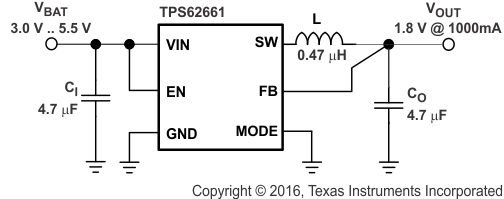 Figure 9. TPS62661 1.8-V Output Voltage
Figure 9. TPS62661 1.8-V Output Voltage
9.2.1 Design Requirements
The device operates over an input voltage range from 2.3 V to 5.5 V.
9.2.2 Detailed Design Procedure
9.2.2.1 Inductor Selection
The TPS62660 series of step-down converters have been optimized to operate with an effective inductance value in the range of 0.3 μH to 1.3 μH and with output capacitors in the range of 4.7 μF to 10 μF. The internal compensation is optimized to operate with an output filter of L = 0.47 μH and CO = 4.7 μF. Larger or smaller inductor values can be used to optimize the performance of the device for specific operation conditions. For more details, see Checking Loop Stability.
The inductor value affects its peak-to-peak ripple current, the PWM-to-PFM transition point, the output voltage ripple, and the efficiency. The selected inductor must be rated for its DC resistance and saturation current. The inductor ripple current (ΔIL) decreases with higher inductance and increases with higher VI or VO.

where
- fSW = switching frequency (6 MHz typical)
- L = inductor value
- ΔIL = peak-to-peak inductor ripple current
- IL(MAX) = maximum inductor current
In high-frequency converter applications, the efficiency is essentially affected by the inductor AC resistance (that is, quality factor) and to a smaller extent by the inductor DCR value. To achieve high-efficiency operation, take care in selecting inductors featuring a quality factor above 25 at the switching frequency. Increasing the inductor value produces lower RMS currents, but degrades transient response. For a given physical inductor size, increased inductance usually results in an inductor with lower saturation current.
The total losses of the coil consist of both the losses in the DC resistance (R(DC)) and the following frequency-dependent components:
- The losses in the core material (magnetic hysteresis loss, especially at high switching frequencies)
- Additional losses in the conductor from the skin effect (current displacement at high frequencies)
- Magnetic field losses of the neighboring windings (proximity effect)
- Radiation losses
The following inductor series from different suppliers have been used with the TPS62660 converters.
Table 2. List of Inductors
| MANUFACTURER | SERIES | DIMENSIONS |
|---|---|---|
| MURATA | LQM21PN1R0NGR | 2.0 × 1.2 × 1.0 max. height |
| LQM21PNR54MGC | 2.0 × 1.2 × 1.0 max. height | |
| LQM2MPN1R0NG0 | 2.0 × 1.6 × 1.0 max. height | |
| PANASONIC | ELGTEAR82NA | 2.0 × 1.2 × 1.0 max. height |
| TOKO | MDT2012-CX1R0A | 2.0 × 1.2 × 1.0 max. height |
| TAIYO YUDEN | NM2012NR82, NM2012N1R0 | 2.0 × 1.2 × 1.0 max. height |
| FDK | MIPS2012D1R0-X2 | 2.0 × 1.2 × 1.0 max. height |
9.2.2.2 Output Capacitor Selection
The advanced fast-response voltage mode control scheme of the TPS6266x allows the use of tiny ceramic capacitors. Ceramic capacitors with low ESR values have the lowest output voltage ripple and are recommended. For best performance, the device must operate within a minimum effective output capacitance of 1.6 μF. The output capacitor requires either an X7R or X5R dielectric. Y5V and Z5U dielectric capacitors, aside from their wide variation in capacitance over temperature, become resistive at high frequencies.
At nominal load current, the device operates in PWM mode and the overall output voltage ripple is the sum of the voltage step caused by the output capacitor ESL and the ripple current flowing through the output capacitor impedance.
At light loads, the output capacitor limits the output ripple voltage and provides holdup during large load transitions. A 4.7-μF capacitor typically provides sufficient bulk capacitance to stabilize the output during large load transitions. The typical output voltage ripple is 1% of the nominal output voltage VO.
The output voltage ripple during PFM mode operation can be kept very small. The PFM pulse is time controlled, which allows to modify the charge transferred to the output capacitor by the value of the inductor. The resulting PFM output voltage ripple and PFM frequency depend in first order on the size of the output capacitor and the inductor value. The PFM frequency decreases with smaller inductor values and increases with larger once. Increasing the output capacitor value and the effective inductance minimizes the output ripple voltage.
9.2.2.3 Input Capacitor Selection
Because of the nature of the buck converter having a pulsating input current, a low ESR input capacitor is required to prevent large voltage transients that can cause misbehavior of the device or interferences with other circuits in the system. For most applications, a 4.7-μF capacitor is sufficient. If the application exhibits a noisy or erratic switching frequency, the remedy is probably found by experimenting with the value of the input capacitor.
Take care when using only ceramic input capacitors. When a ceramic capacitor is used at the input and the power is being supplied through long wires, such as from a wall adapter, a load step at the output can induce ringing at the VIN pin. This ringing can couple to the output and be mistaken as loop instability or could even damage the part. Additional bulk capacitance (electrolytic or tantalum) must in this circumstance be placed between CI and the power source lead to reduce ringing than can occur between the inductance of the power source leads and CI.
9.2.2.4 Checking Loop Stability
The first step of circuit and stability evaluation is to look from a steady-state perspective at the following signals:
- Switching node, SW
- Inductor current, IL
- Output ripple voltage, VO(AC)
These are the basic signals that need to be measured when evaluating a switching converter. When the switching waveform shows large duty cycle jitter or the output voltage or inductor current shows oscillations, the regulation loop may be unstable. This is often a result of board layout or L-C combination.
As a next step in the evaluation of the regulation loop, the load transient response is tested. The time between the application of the load transient and the turnon of the P-channel MOSFET, the output capacitor must supply all of the current required by the load. VO immediately shifts by an amount equal to ΔI(LOAD) × ESR, where ESR is the effective series resistance of CO. ΔI(LOAD) begins to charge or discharge CO generating a feedback error signal used by the regulator to return VO to its steady-state value. The results are most easily interpreted when the device operates in PWM mode.
During this recovery time, VO can be monitored for settling time, overshoot or ringing that helps judge the converter’s stability. Without any ringing, the loop has usually more than 45° of phase margin.
Because the damping factor of the circuitry is directly related to several resistive parameters (for example, MOSFET rDS(on)) that are temperature dependant, the loop stability analysis has to be done over the input voltage range, load current range, and temperature range.
9.2.3 Application Curves
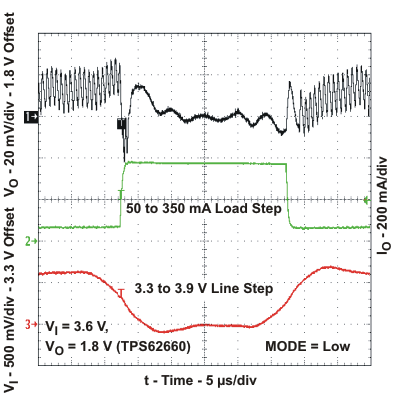 Figure 10. Combined Line and Load Transient Response
Figure 10. Combined Line and Load Transient Response
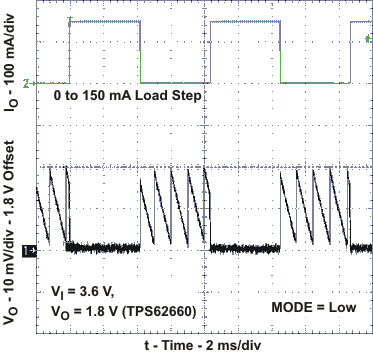 Figure 12. Load Transient Response in PFM/PWM Operation
Figure 12. Load Transient Response in PFM/PWM Operation
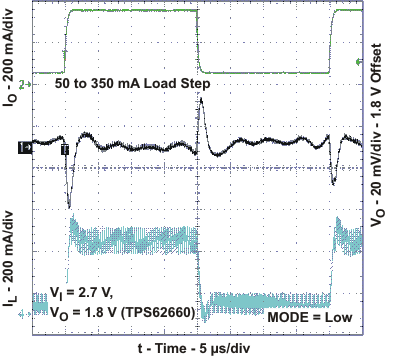 Figure 14. Load Transient Response in PFM/PWM Operation
Figure 14. Load Transient Response in PFM/PWM Operation
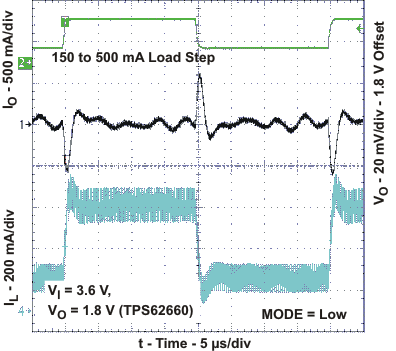 Figure 16. Load Transient Response in PFM/PWM Operation
Figure 16. Load Transient Response in PFM/PWM Operation
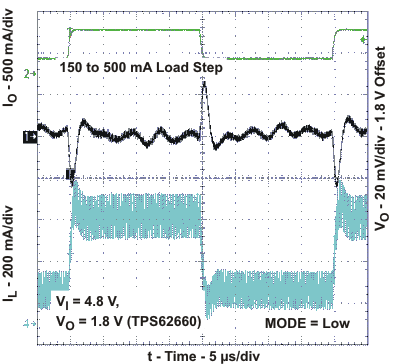 Figure 18. Load Transient Response in PFM/PWM Operation
Figure 18. Load Transient Response in PFM/PWM Operation
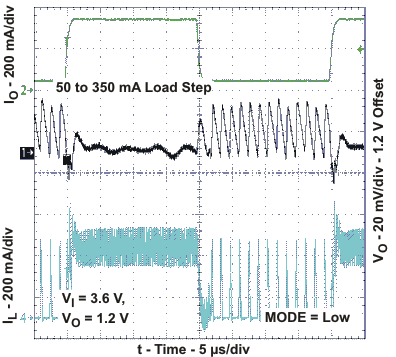 Figure 20. Load Transient Response in PFM/PWM Operation
Figure 20. Load Transient Response in PFM/PWM Operation
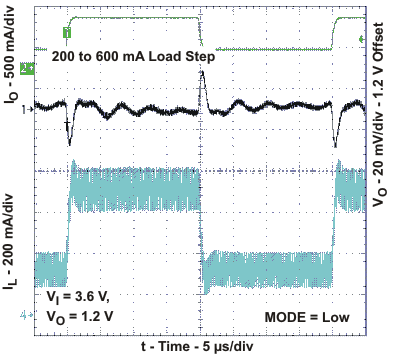 Figure 22. Load Transient Response in PFM/PWM Operation
Figure 22. Load Transient Response in PFM/PWM Operation
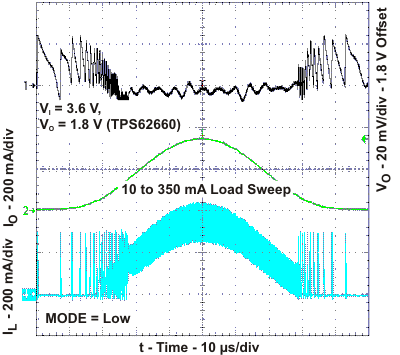 Figure 24. AC Load Transient Response
Figure 24. AC Load Transient Response
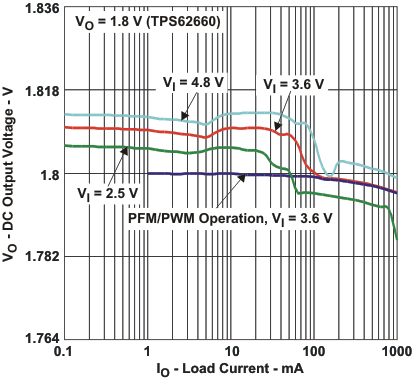 Figure 26. DC Output Voltage vs Load Current
Figure 26. DC Output Voltage vs Load Current
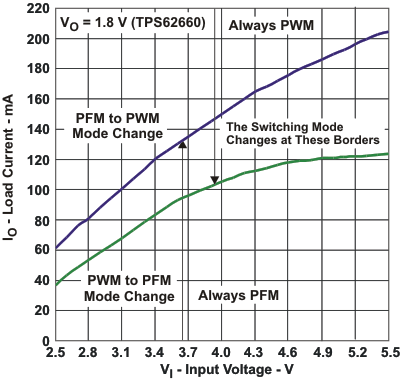 Figure 28. PFM/PWM Boundaries
Figure 28. PFM/PWM Boundaries
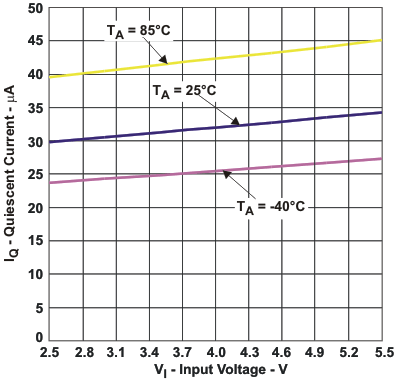 Figure 30. Quiescent Current vs Input Voltage
Figure 30. Quiescent Current vs Input Voltage
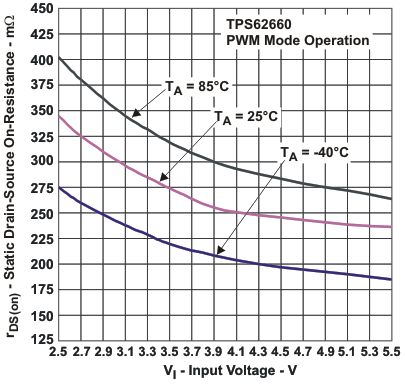 Figure 32. P-Channel rDS(ON) vs Input Voltage
Figure 32. P-Channel rDS(ON) vs Input Voltage
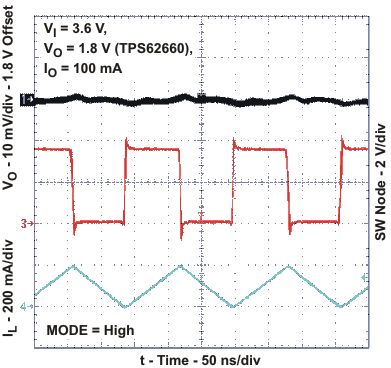 Figure 34. PWM Operation
Figure 34. PWM Operation
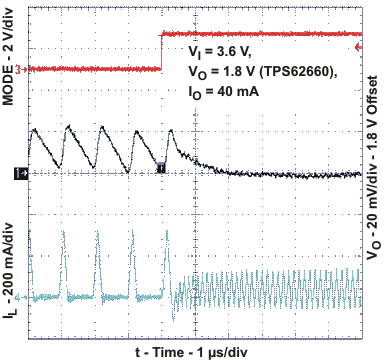 Figure 36. Mode Change Response
Figure 36. Mode Change Response
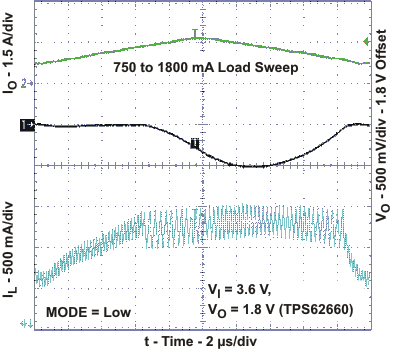 Figure 38. Overcurrent Fault Operation
Figure 38. Overcurrent Fault Operation
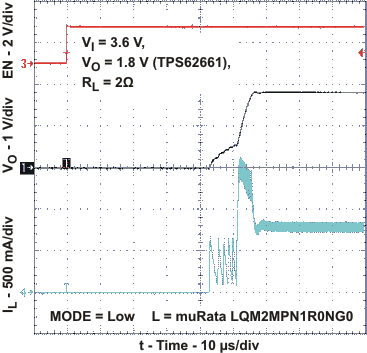 Figure 40. Start-Up
Figure 40. Start-Up
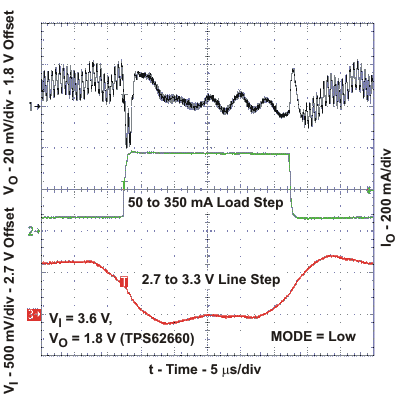 Figure 11. Combined Line and Load Transient Response
Figure 11. Combined Line and Load Transient Response
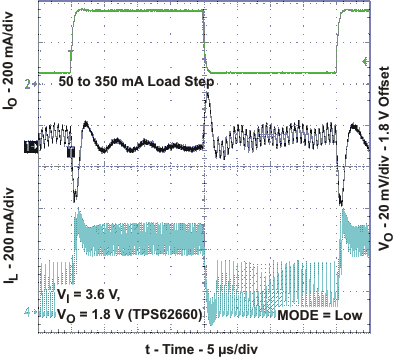 Figure 13. Load Transient Response in PFM/PWM Operation
Figure 13. Load Transient Response in PFM/PWM Operation
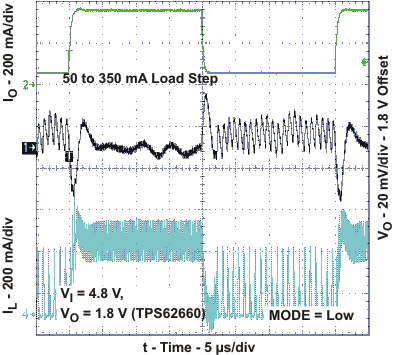 Figure 15. Load Transient Response in PFM/PWM Operation
Figure 15. Load Transient Response in PFM/PWM Operation
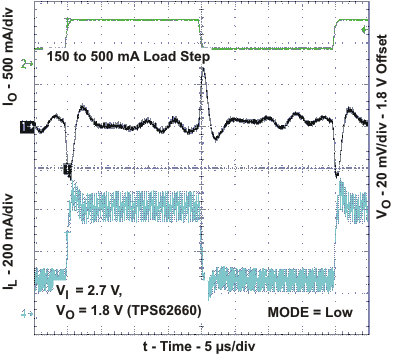 Figure 17. Load Transient Response in PFM/PWM Operation
Figure 17. Load Transient Response in PFM/PWM Operation
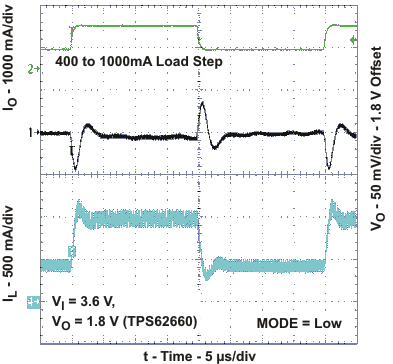 Figure 19. Load Transient Response in PFM/PWM Operation
Figure 19. Load Transient Response in PFM/PWM Operation
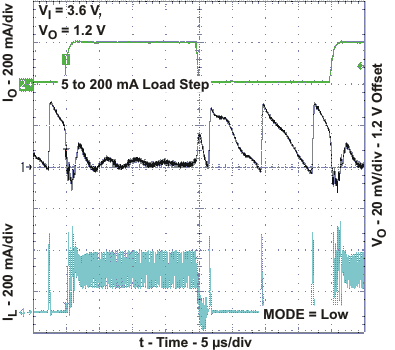 Figure 21. Load Transient Response in PFM/PWM Operation
Figure 21. Load Transient Response in PFM/PWM Operation
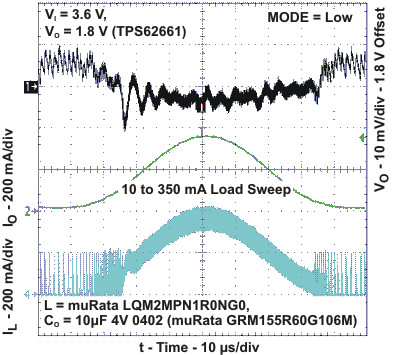 Figure 23. AC Load Transient Response
Figure 23. AC Load Transient Response
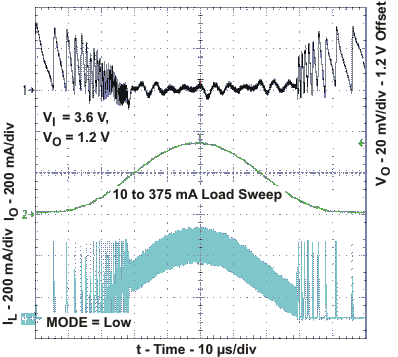 Figure 25. AC Load Transient Response
Figure 25. AC Load Transient Response
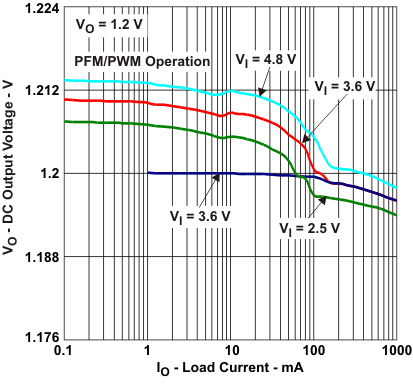 Figure 27. DC Output Voltage vs Load Current
Figure 27. DC Output Voltage vs Load Current
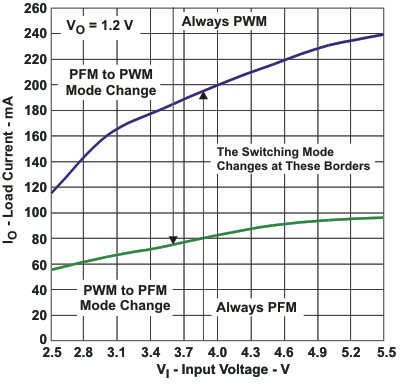 Figure 29. PFM/PWM Boundaries
Figure 29. PFM/PWM Boundaries
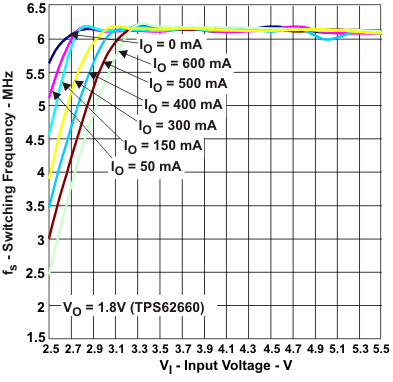 Figure 31. Switching Frequency vs Input Voltage
Figure 31. Switching Frequency vs Input Voltage
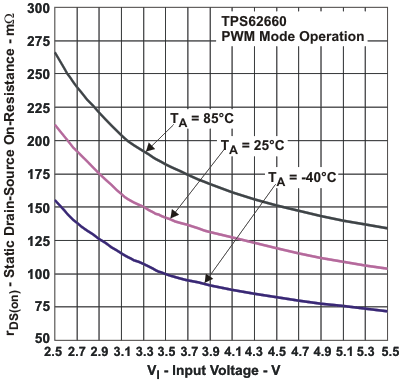 Figure 33. N-Channel rDS(ON) vs Input Voltage
Figure 33. N-Channel rDS(ON) vs Input Voltage
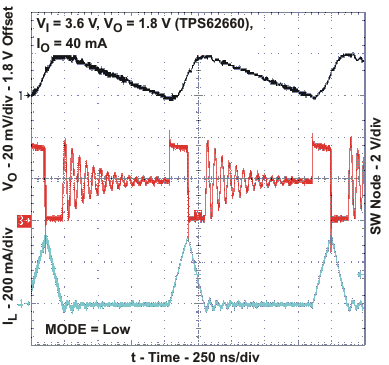 Figure 35. Power-Save Mode Operation
Figure 35. Power-Save Mode Operation
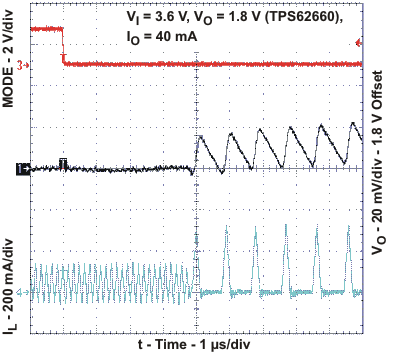 Figure 37. Mode Change Response
Figure 37. Mode Change Response
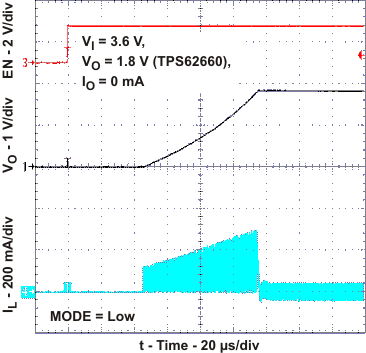 Figure 39. Start-Up
Figure 39. Start-Up